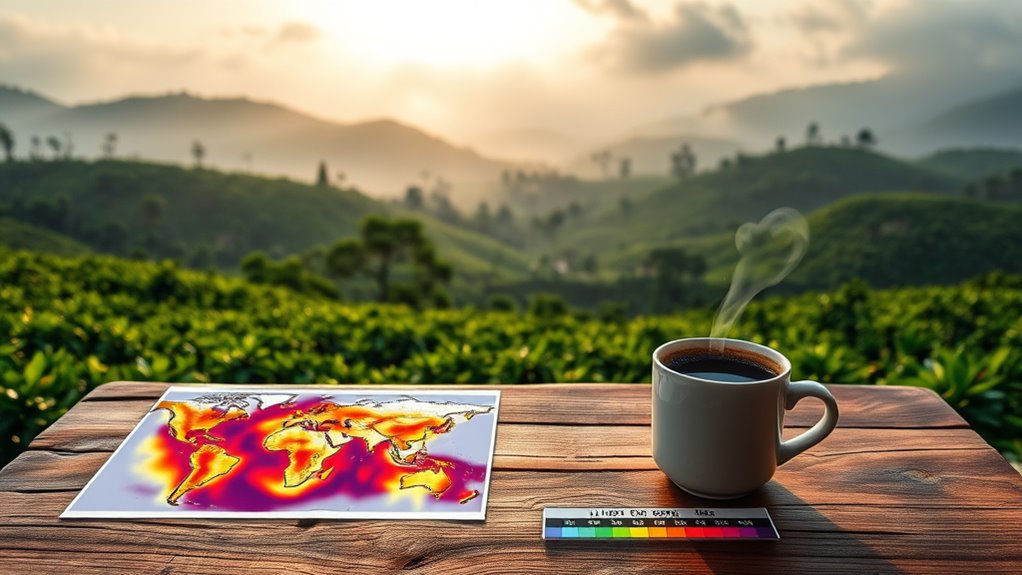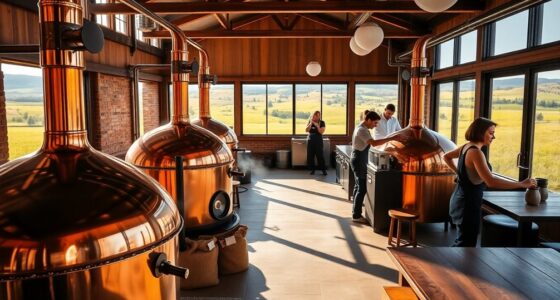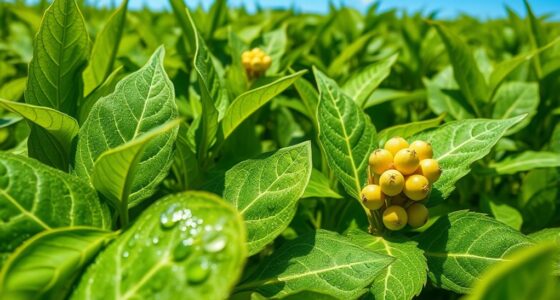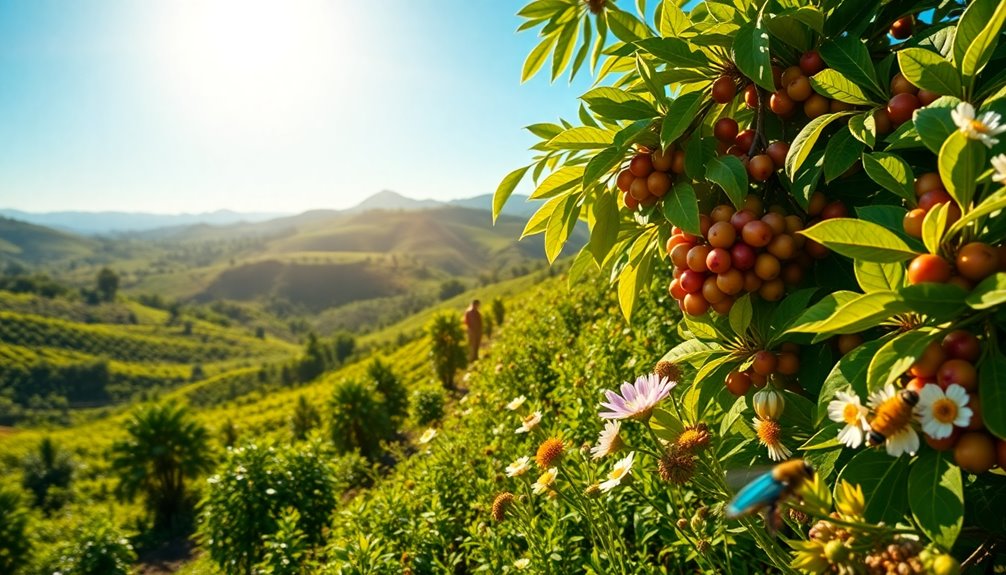Climate models show that warming temperatures are shifting the ideal coffee-growing region, known as the bean belt, to higher elevations. As lower-altitude areas become too warm, coffee farmers need to move their crops upward, changing traditional cultivation zones. Pest migration also follows these shifts, posing new risks. Understanding these models helps you see how climate change impacts coffee crops now and in the future. Keep exploring to discover how these changes could affect your coffee choices.
Key Takeaways
- Climate models predict rising temperatures shift optimal coffee-growing zones to higher elevations.
- Warming enables pests like the coffee borer beetle to migrate to higher altitudes, threatening new regions.
- Models identify areas at risk of crop decline due to unsuitable temperatures and pest invasions.
- They help forecast changes in the Bean Belt’s geographic location and coffee production potential.
- Climate simulations guide farmers and policymakers in developing adaptation and pest management strategies.

Climate models are essential tools for understanding how changing weather patterns will affect coffee production worldwide. As global temperatures rise, you’ll notice shifts in the traditional coffee-growing regions, often moving the ideal altitude zones higher into the mountains. These altitude shifts mean that areas once perfect for coffee cultivation may become too warm, forcing farmers and industry experts to rethink where beans can thrive. The cooler, higher elevations will become new hotspots, but this changeover isn’t without challenges. You might see some regions struggle to adapt quickly enough, risking reduced yields and compromised quality. Understanding these shifts helps you anticipate where coffee will grow best in the future and highlights the importance of climate resilience.
One of the most immediate effects of warming is pest migration. As temperatures increase, pests like the coffee borer beetle, a major threat to coffee plants, are migrating to higher elevations where they previously couldn’t survive. This change means that pests will now attack coffee plants in regions that were once safe, expanding the disease risk across different altitudes. For you, this means increased pressure on farmers to implement pest management strategies and adopt resistant coffee varieties. Pest migration complicates the fight against coffee diseases, and climate models help predict these movements, giving you a clearer picture of future risks. Without this knowledge, managing pests would be more reactive than proactive, leading to higher costs and lower yields.
Altitude shifts and pest migration are interconnected phenomena driven by warming temperatures. As pests move upward, they threaten crops located at higher elevations, which were traditionally less vulnerable. This puts additional stress on farmers, who may need to alter their practices or invest in new technologies to protect their crops. Climate models simulate these scenarios, allowing you to see potential future outcomes and plan accordingly. They also help identify regions where pests might invade next, enabling early interventions that can save entire harvests. Recognizing these patterns empowers you to understand the complex dynamics at play and underscores the urgency of adapting current practices to safeguard coffee production.
Frequently Asked Questions
How Accurate Are Current Climate Models for Predicting Future Coffee-Growing Regions?
Current climate models have moderate reliability in predicting future coffee-growing regions, but prediction accuracy can vary. You should know that these models incorporate many variables, yet uncertainties remain due to complex climate interactions. While they give valuable insights, they aren’t perfect. You need to stay updated on new data and improvements, as model reliability continues to evolve, helping farmers and stakeholders better plan for potential shifts in coffee cultivation zones.
What Are the Potential Economic Impacts on Coffee Farmers Due to Climate Change?
You face significant economic vulnerability as climate change impacts coffee production, risking reduced yields and quality. This leads to increased price volatility, making your income unpredictable. As growing regions shift and some become unsuitable, you might need to invest in new areas or adapt farming practices, which could be costly. Staying informed and flexible is essential to managing these economic risks and maintaining your livelihood amid changing climate conditions.
Can New Coffee Varieties Withstand the Changing Climate Conditions?
You’ll be pleased to know that new coffee varieties are being developed to withstand climate shifts. About 70% of these new crops are drought-resistant, giving farmers a better chance during dry spells. Shade-grown coffee also helps protect against temperature extremes. These innovations aim to guarantee your favorite brew remains sustainable, even as climate change alters growing conditions. With ongoing research, coffee’s future looks more resilient for both farmers and consumers.
How Might Shifting Climate Zones Affect Global Coffee Supply Chains?
Shifting climate zones can disrupt your global coffee supply chains by forcing you to adapt to new growing regions. To stay resilient, you should focus on sustainable farming practices and crop diversification, which help mitigate risks from climate variability. These strategies enable you to maintain coffee quality and availability, ensuring that your supply chain remains stable despite changing environmental conditions. Embracing such adaptations secures your access to coffee in the future.
Are There Any Innovative Farming Practices to Adapt to Climate Change?
You can adopt innovative farming practices like sustainable farming and agroforestry to adapt to climate change. Incorporating agroforestry practices, such as planting shade trees, helps protect coffee plants from extreme temperatures and reduces water stress. Sustainable farming methods, like crop diversification and soil conservation, improve resilience and soil health. These strategies enable you to maintain productivity while minimizing environmental impact, ensuring a more resilient coffee supply chain amid changing climate conditions.
Conclusion
As you explore how climate models predict changes in coffee-growing regions, remember that over 25% of the world’s coffee comes from areas likely to shift due to warming. This means that in just a few decades, your favorite brew could come from entirely different places. Staying informed helps you appreciate the future of coffee and the importance of climate action. So, next time you sip your coffee, think about how climate change might shape its journey to your cup.










